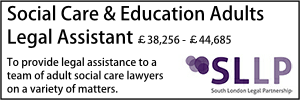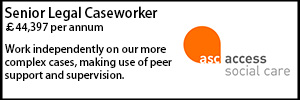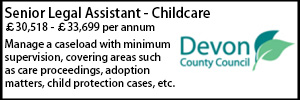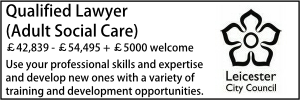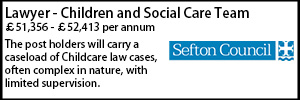Judges allow appeal over flawed reasoning in fact-finding judgment
- Details
The Court of Appeal have allowed a challenge by the parents of a young girl to a finding made in care proceedings that, when she was a small baby, she suffered an abusive head injury inflicted by one or other of the parents.
In A (A Child) (Fact-Finding: Head Injury) [2024] EWCA Civ 327, Lord Justice Baker concluded that the judge’s treatment of the possibility that the injury was sustained accidentally was “unsatisfactory”. Further, the judge “did not carry out a sufficiently detailed analysis of [the parents’] evidence to form a clear view of their credibility and reliability”.
The case concerned a young girl, referred to as ‘A’.
Baker LJ noted that the family was unknown to social services and had no involvement with the courts before the event that triggered proceedings, which occurred when A was 2 months old.
He set out the parents' account of the event as follows:
“According to the mother, she was woken at about 4 o'clock by A in the early hours of 19 February 2022. Leaving A in her cot, she went downstairs to prepare a bottle of milk. She was away for about five minutes. As she was coming upstairs, she heard a scream, ran into the room, and found A in her father's arms, arching her back in pain.
“According to the father, when he woke he had gone to the bathroom and on returning he picked A up from the cot and took her into bed to settle her. She was arching her back and crying and, as the mother was coming upstairs, she screamed. A was unresponsive to her parents' attempts to rouse her so they called 111 and then 999.”
A was taken to hospital by ambulance where, following an MRI scan, she was diagnosed with a subdural haematoma. Following this she immediately underwent surgery.
The opinion of the treating clinicians was that the injury “could not be explained by a natural cause” but rather had been caused by a traumatic event of some kind, said Baker LJ.
The parents did not point to any such event and said that they did not know how the injuries were caused.
On 11 March 2022, the local authority started care proceedings and, on discharge from hospital, A was placed with her maternal grandparents under an interim care order. Baker LJ noted that over two years on, this is where A remains.
He said: “With the local authority's approval, her parents have moved into the property and have supervised contact. Fortunately, A seems to have made a good recovery from her injury. There have been no concerns about the care she has received within the family or about her relationship with her parents.”
The Court of Appeal judge noted that although the case revolved around a single incident, the fact-finding hearing was not completed until 20 months after the start of the proceedings.
At a case management hearing on 29 March 2022, HH Judge Cronin gave permission for the instruction of three medical expert witnesses - Mr Jayaratnam Jayamohan, consultant paediatric neurosurgeon, Professor Stavros Stivaros, consultant paediatric neuroradiologist, and Dr George Rylance, a retired consultant paediatrician.
A report was also filed by Dr Tim Hookway, consultant obstetrician and gynaecologist, following a further court direction.
The fact-finding hearing started on 20 February 2023. The local authority sought a finding that A's head injury had been inflicted by one or other of her parents, noted Baker LJ.
Judgment was handed down on 20 October, in which the judge found that the injury had been inflicted by either the mother or the father.
At a hearing on 15 November 2023, the judge responded orally to a request for clarification, with corresponding changes made to the judgment in the form of track changes to the original draft, said Baker LJ.
The judge's findings were recorded as follows:
- The injury occurred in the early hours of the morning of the 19 February 2022 at or soon after 4am.
- A had a large torn cortical bridging vein which could not have been caused by any identified natural process.
- A suffered an abusive injury in the course of an undisclosed traumatic event at about 4am on 19 February 2022. This would have been by way of an acceleration or deceleration action with or without impact against a soft object and it caused a significant injury to her head.
- There is no evidence that there was an undisclosed accident which caused her injury.
- One of the parents has lied about not knowing what has happened. Both parents deny any knowledge of a traumatic event. Neither parent's evidence on this point is accepted.
- The court did not find that it is more probable that either parent was responsible and so both remain potential perpetrators.
- A suffered significant harm in the form of an abusive head injury whilst in the care of both of her parents and that harm was attributable to the care being given to her not being what it was reasonable to expect a parent to provide.
- There was no evidence that either of them should have recognised that the other presented a risk before this. Neither of them failed to protect her from injury before February 2022.
Turning to the present appeal, Baker LJ noted that counsel for the mother put forward 6 grounds of appeal, and counsel for the father put forward 11 grounds of appeal.
However, he said: “There was plainly a considerable degree of overlap between these various grounds advanced by the two appellants, so in granting permission to appeal I asked their representatives to liaise to refine the grounds and arguments in support.”
The grounds were summarised as follows:
- The judge erroneously considered the medical evidence in isolation.
- She converted the collective medical opinion into a "finding".
- Her conclusion that the medical evidence demonstrated that there must have been an abusive event was not a reflection of the medical opinion that she had received.
- In her analysis of the medical evidence, she failed to undertake any assessment of the impact of her not being satisfied of the existence of two out of three purported injuries, identified by some of the medical experts and assumed (out of deference) by others to exist.
- Her finding led her to the conclusion that one or other of the parents must be lying.
- In reaching that conclusion, she failed to undertake an analysis of the broad canvas or the specific evidence that each of the parents gave.
- By undertaking her analysis in this way, she reversed the burden of proof and/or put the onus on the appellant mother to exclude herself from being in the pool of possible perpetrators.
- The judgment lacked analytical rigour, was contradictory, and contained impermissible speculation.
Counsel for the local authority “acknowledged the differences of opinion” between the medical experts, but submitted that their important overall opinion – that trauma was the likeliest explanation for the injury – remained unchanged, said Baker LJ.
It was also submitted that the judge had proceeded to consider the parents' evidence and their various explanations or suggestions as to how A's injury had been sustained. Therefore, she had been entitled to form the view that she could not find them to be credible witnesses about the events leading to A's hospital admission.
Before considering the appeal, Baker LJ made three “general observations” about the hearing and judgment:
“First, it is highly unusual and in principle unsatisfactory for a fact-finding hearing to be adjourned for several months in the way that occurred in this case. The hearing started in February, was adjourned in March, adjourned again in July, and only concluded in October. I understand why the judge agreed to the adjournments. She wanted to leave no stone unturned in trying to find a medical explanation for the injury which A had sustained and acceded to applications for further expert assessment. We did not explore whether the judge was right to allow the additional assessments or the reason why the applications were made at such a late stage in the proceedings. It is, however, highly regrettable that the need for these additional experts was not identified at an earlier stage.
“Secondly, most of the oral evidence was heard in February and March. So far as I am aware, no evidence was given in July and only one witness – the expert haematologist – in October. Thus the judgment was delivered over eight months after the key evidence had been given. On any view, this must have presented a considerable challenge to the judge.
“Thirdly, whilst appreciating the judge's good intentions in amending the judgment in response to the requests for clarification, the final track changed version does not fully clarify ambiguities in the judge's reasoning but instead in some respects causes further uncertainty. The better course would have been to respond to the request for clarification in a separate document in so far as a response was merited in accordance with principles established in case law.”
Turning to the matters raised on behalf of the parents, Baker LJ said: “It is clear that, during a series of hearings extending over many months, the judge devoted a great deal of care and attention to this troubling case. It is therefore very unfortunate that in her final judgment there are a number of significant flaws in the judge's reasoning.”
He said: “Having concluded (at paragraph 113) that A "had a large torn cortical bridging vein which could not have been caused by any identified natural process" but that she was "not satisfied that she had multi-locational bleeding", the judge then immediately concluded (at paragraph 114) that A "suffered an abusive injury in the course of an undisclosed traumatic event".
“She reached the conclusion that the injury was (a) as a result of a traumatic event and (b) inflicted abusively without giving due consideration to the totality of the evidence, including the evidence of and about the parents.”
Baker LJ found that the judge's treatment of the possibility that the injury was sustained accidentally was “unsatisfactory”. He also found a flaw in the judge's treatment of the issue of timing.
He noted that in paragraph 122, the judge “briefly summarised” the parents' case that the child collapsed during a five-minute period when the mother was downstairs and the father woke up, went to the bathroom, and, on returning, picked up the child. The judge then discounted this point by making “several speculative observations”.
He said: “She ought not to have reached a conclusion that one or both of the parents had withheld information without considering all of the evidence, including their evidence about timing.”
Finally, Baker LJ found a flaw in the judge's reasoning in concluding that both parents remain in the pool of possible perpetrators.
He observed: “The judge did not consider each parent separately as she was required to do. She did not carry out a sufficiently detailed analysis of their evidence to form a clear view of their credibility and reliability. She concluded that one of them had lied and the other was "at best naïve". Contrary to the course prescribed by King LJ in Re A, she asked herself whether she could distinguish between the parents. She concluded she could not "without direct evidence of the traumatic event that must have taken place".”
Baker LJ concluded that both appeals must be allowed.
He said: “Ideally this Court should try to arrive at an outcome that enables the proceedings to come to an end today. Regrettably, I do not think we are in a position to do so.
“[…] If My Lord and My Lady agree, I would remit the proceedings to the Family Presiding Judge for the Western Circuit, Judd J, to decide what course of action should now be followed. It may be that one or other party will propose that a rehearing of the fact-finding hearing is unnecessary and disproportionate in the circumstances. Alternatively, it may be suggested that the rehearing should go ahead before Judd J or another experienced family judge on a curtailed basis, relying on transcripts of some of the evidence given at the first hearing and confining the oral evidence to a limited number of witnesses.
“I make no comment as to which course should be followed, save to say that I hope that a way can be found to avoid a full rehearing which, even if it did not require the fifteen days originally allocated, would undoubtedly involve significant resources and lead to further delay before final decisions can be taken about A's future.”
Lord Justice Nugee and Lady Justice Falk agreed.
Lottie Winson





















